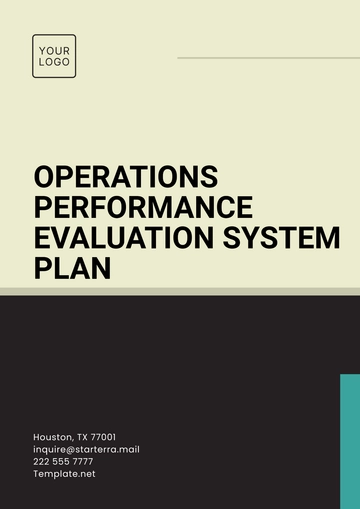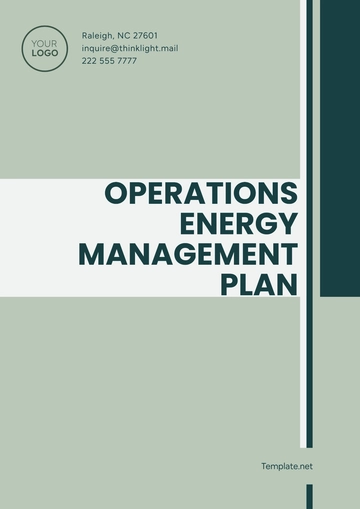Free Compliance Plan for Manufacturing Plants

Date: [Date]
Prepared By: [Your Name]
I. Executive Summary
The Product Quality Compliance Plan outlines the steps, procedures, and processes that ensure all products meet the required quality standards and comply with industry regulations. The plan aims to provide a clear framework for quality assurance, regulatory compliance, and continuous improvement throughout the product lifecycle.
II. Purpose
The primary purpose of this plan is to guarantee that all products manufactured and distributed by the company are of the highest quality, safe for use, and compliant with applicable regulatory requirements. This plan will guide the organization in maintaining consistent product quality, improving processes, and addressing any compliance issues that arise.
III. Scope
The scope of this Product Quality Compliance Plan includes:
Product Design and Development: Ensuring that all products meet quality standards during the design and development phase.
Manufacturing Processes: Maintaining high-quality control and compliance throughout the manufacturing process.
Supplier and Vendor Management: Ensuring that raw materials and components from suppliers meet regulatory and quality standards.
Testing and Inspections: Conducting quality tests and inspections at key stages of production.
Documentation and Reporting: Maintaining proper records to ensure transparency and traceability.
Regulatory Compliance: Meeting the standards and certifications required by industry-specific regulations.
IV. Compliance Standards and Regulations
The plan adheres to the following regulatory and quality standards:
ISO 9001 (Quality Management Systems)
ISO 13485 (Medical Device Quality Management)
FDA 21 CFR Part 820 (Quality System Regulation)
CE Marking (European Union Product Safety)
Other industry-specific standards as required
V. Quality Control Procedures
Design Controls:
Clear product specifications.
Risk assessments and analysis during the design phase.
Regular reviews to ensure compliance with standards.
Manufacturing Control:
Detailed procedures for production quality checks.
In-process inspections and testing at critical stages of production.
Statistical process control to identify and correct defects early.
Supplier Quality Management:
Qualification and auditing of suppliers.
Regular assessments to ensure that raw materials meet the required quality specifications.
Final Product Testing and Inspection:
Comprehensive testing of finished products.
Compliance with regulatory standards.
Documentation of test results and certifications.
VI. Corrective and Preventive Actions (CAPA)
The CAPA system will be implemented to identify, investigate, and address any product quality issues or non-compliance. The process includes:
Root Cause Analysis: Identifying the underlying cause of quality issues.
Corrective Actions: Developing solutions to address the problem.
Preventive Actions: Implementing measures to prevent recurrence.
Documentation: Maintaining records of all CAPA actions for future reference and audits.
VII. Training and Education
All employees involved in product development, manufacturing, and quality assurance will undergo regular training to stay updated on compliance regulations and quality standards. This includes:
Workshops on product quality standards.
Training on regulatory changes and industry best practices.
Regular assessments of employee knowledge on quality and compliance topics.
VIII. Documentation and Reporting
A comprehensive record-keeping system will be established to ensure traceability and transparency of all quality and compliance activities. This will include:
Product specifications and design documentation.
Quality inspection and test reports.
Supplier certifications and audit results.
CAPA documentation and follow-up actions.
IX. Continuous Improvement
The Product Quality Compliance Plan emphasizes continuous improvement through regular evaluations, audits, and feedback loops. Key metrics such as defect rates, customer satisfaction, and compliance audits will be monitored to drive ongoing improvements.
X. Evaluation Process and Metrics
To evaluate the effectiveness of the Product Quality Compliance Plan, the following metrics will be tracked:
Defect rates and product returns.
Supplier performance and material quality.
Compliance audit results.
Customer feedback and satisfaction surveys.
CAPA effectiveness and resolution time.
XI. Conclusion
The Product Quality Compliance Plan serves as a critical framework for ensuring that the company's products meet the highest quality standards while complying with relevant regulations. Through rigorous testing, supplier management, and continuous improvement efforts, the company aims to deliver safe, high-quality products to its customers.
- 100% Customizable, free editor
- Access 1 Million+ Templates, photo’s & graphics
- Download or share as a template
- Click and replace photos, graphics, text, backgrounds
- Resize, crop, AI write & more
- Access advanced editor
Ensure your manufacturing plant meets all regulatory requirements with the Compliance Plan for Manufacturing Plants Template, offered by Template.net. This customizable and editable in our AI Editor Tool template allows you to tailor the compliance plan to suit your plant's specific needs. Downloadable and printable, it ensures you can easily manage and implement compliance protocols, saving time and ensuring adherence to industry standards. Streamline your compliance process today with this essential tool for manufacturing plants.
You may also like
- Finance Plan
- Construction Plan
- Sales Plan
- Development Plan
- Career Plan
- Budget Plan
- HR Plan
- Education Plan
- Transition Plan
- Work Plan
- Training Plan
- Communication Plan
- Operation Plan
- Health And Safety Plan
- Strategy Plan
- Professional Development Plan
- Advertising Plan
- Risk Management Plan
- Restaurant Plan
- School Plan
- Nursing Home Patient Care Plan
- Nursing Care Plan
- Plan Event
- Startup Plan
- Social Media Plan
- Staffing Plan
- Annual Plan
- Content Plan
- Payment Plan
- Implementation Plan
- Hotel Plan
- Workout Plan
- Accounting Plan
- Campaign Plan
- Essay Plan
- 30 60 90 Day Plan
- Research Plan
- Recruitment Plan
- 90 Day Plan
- Quarterly Plan
- Emergency Plan
- 5 Year Plan
- Gym Plan
- Personal Plan
- IT and Software Plan
- Treatment Plan
- Real Estate Plan
- Law Firm Plan
- Healthcare Plan
- Improvement Plan
- Media Plan
- 5 Year Business Plan
- Learning Plan
- Marketing Campaign Plan
- Travel Agency Plan
- Cleaning Services Plan
- Interior Design Plan
- Performance Plan
- PR Plan
- Birth Plan
- Life Plan
- SEO Plan
- Disaster Recovery Plan
- Continuity Plan
- Launch Plan
- Legal Plan
- Behavior Plan
- Performance Improvement Plan
- Salon Plan
- Security Plan
- Security Management Plan
- Employee Development Plan
- Quality Plan
- Service Improvement Plan
- Growth Plan
- Incident Response Plan
- Basketball Plan
- Emergency Action Plan
- Product Launch Plan
- Spa Plan
- Employee Training Plan
- Data Analysis Plan
- Employee Action Plan
- Territory Plan
- Audit Plan
- Classroom Plan
- Activity Plan
- Parenting Plan
- Care Plan
- Project Execution Plan
- Exercise Plan
- Internship Plan
- Software Development Plan
- Continuous Improvement Plan
- Leave Plan
- 90 Day Sales Plan
- Advertising Agency Plan
- Employee Transition Plan
- Smart Action Plan
- Workplace Safety Plan
- Behavior Change Plan
- Contingency Plan
- Continuity of Operations Plan
- Health Plan
- Quality Control Plan
- Self Plan
- Sports Development Plan
- Change Management Plan
- Ecommerce Plan
- Personal Financial Plan
- Process Improvement Plan
- 30-60-90 Day Sales Plan
- Crisis Management Plan
- Engagement Plan
- Execution Plan
- Pandemic Plan
- Quality Assurance Plan
- Service Continuity Plan
- Agile Project Plan
- Fundraising Plan
- Job Transition Plan
- Asset Maintenance Plan
- Maintenance Plan
- Software Test Plan
- Staff Training and Development Plan
- 3 Year Plan
- Brand Activation Plan
- Release Plan
- Resource Plan
- Risk Mitigation Plan
- Teacher Plan
- 30 60 90 Day Plan for New Manager
- Food Safety Plan
- Food Truck Plan
- Hiring Plan
- Quality Management Plan
- Wellness Plan
- Behavior Intervention Plan
- Bonus Plan
- Investment Plan
- Maternity Leave Plan
- Pandemic Response Plan
- Succession Planning
- Coaching Plan
- Configuration Management Plan
- Remote Work Plan
- Self Care Plan
- Teaching Plan
- 100-Day Plan
- HACCP Plan
- Student Plan
- Sustainability Plan
- 30 60 90 Day Plan for Interview
- Access Plan
- Site Specific Safety Plan





























